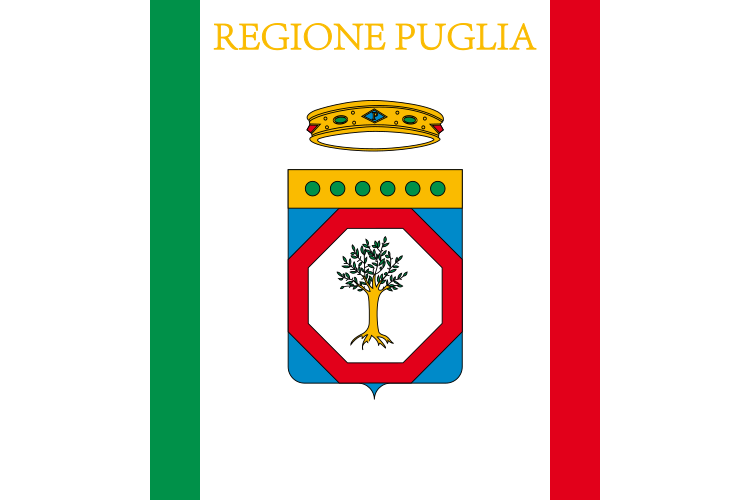
Size of this PNG preview of this SVG file: 750 × 500 pixels. Other resolutions: 320 × 213 pixels | 640 × 427 pixels | 1,024 × 683 pixels | 1,280 × 853 pixels | 2,560 × 1,707 pixels.
Original file (SVG file, nominally 750 × 500 pixels, file size: 82 KB)
File history
Click on a date/time to view the file as it appeared at that time.
| Date/Time | Thumbnail | Dimensions | User | Comment | |
|---|---|---|---|---|---|
| current | 15:19, 28 February 2020 |  | 750 × 500 (82 KB) | Facquis | Correct design |
| 00:14, 2 December 2012 |  | 750 × 500 (72 KB) | ANGELUS |
File usage
More than 100 pages use this file. The following list shows the first 100 pages that use this file only. A full list is available.
- 2006 Italian general election
- Acquarica del Capo
- Apulia
- Avetrana
- Bar, Ukraine
- Biccari
- Botrugno
- Calimera
- Cannole
- Canosa di Puglia
- Caprarica di Lecce
- Carovigno
- Carpignano Salentino
- Carpino
- Casarano
- Cassano delle Murge
- Castellana Grotte
- Castri di Lecce
- Castrignano del Capo
- Cellamare
- Celle di San Vito
- Chieuti
- Collepasso
- Corato
- Corigliano d'Otranto
- Corsano
- Cursi
- Deliceto
- Economy of Italy
- European cuisine
- Faeto
- Flags of Europe
- Flags of regions of Italy
- Foggia
- Football in Italy
- Gagliano del Capo
- Galatone
- Gioia del Colle
- Griko language
- ISO 3166-2:IT
- Italian wine
- Lequile
- List of animals representing first-level administrative country subdivisions
- List of current presidents of regions of Italy
- List of language names
- List of the first openly LGBT holders of political offices
- Lucera
- Martano
- Martignano
- Melendugno
- Melissano
- Melpignano
- Milan Bergamo Airport
- Minervino Murge
- Modugno
- Monopoli
- NUTS statistical regions of Italy
- Nardò
- Neviano
- Noci
- Ordona
- Orsara di Puglia
- Panni, Apulia
- Peschici
- Pietramontecorvino
- Politics of Italy
- Province of Bari
- Province of Barletta-Andria-Trani
- Province of Brindisi
- Province of Foggia
- Province of Lecce
- Province of Taranto
- Pulsano
- Putignano
- Regions of Italy
- Rocchetta Sant'Antonio
- Salento
- Sammichele di Bari
- San Cesario di Lecce
- San Donato di Lecce
- San Michele Salentino
- San Vito dei Normanni
- Sannicandro di Bari
- Senate of the Republic (Italy)
- Serie B
- Sogliano Cavour
- Soleto
- Southern Italy
- Sternatia
- Stornara
- Supersano
- Tourism in Italy
- Triggiano
- Turi, Apulia
- Turin Airport
- Ugento
- Valenzano, Apulia
- Vernole
- Zollino
- User:Aetheling1125
View more links to this file.
Global file usage
The following other wikis use this file:
- Usage on af.wikipedia.org
- Usage on als.wikipedia.org
- Usage on an.wikipedia.org
- Usage on ar.wikipedia.org
- Usage on arz.wikipedia.org
- Usage on ast.wikipedia.org
- Usage on avk.wikipedia.org
- Usage on ay.wikipedia.org
- Usage on azb.wikipedia.org
View more global usage of this file.





Well, that’s interesting to know that Psilotum nudum are known as whisk ferns. Psilotum nudum is the commoner species of the two. While the P. flaccidum is a rare species and is found in the tropical islands. Both the species are usually epiphytic in habit and grow upon tree ferns. These species may also be terrestrial and grow in humus or in the crevices of the rocks.
View the detailed Guide of Psilotum nudum: Detailed Study Of Psilotum Nudum (Whisk Fern), Classification, Anatomy, Reproduction